Tips for preventing and treating epithelial ingrowth after LASIK
There are a number of treatment options available if epithelial ingrowth occurs.

Epithelial ingrowth after LASIK is a known complication occurring in 0.2% to 0.4% of cases. The incidence may be higher, up to 15% of cases, when adherence to meticulous surgical technique is not followed. It may remain as an innocuous, nonprogressive condition or may progress to become a potentially sight-threatening condition.
Clinical features
 Amar Agarwal |
Symptoms: Epithelial ingrowth may be mild, which is usually asymptomatic and seen on routine evaluation. In moderate cases, the patient may have foreign body sensation, photophobia, congestion, pain, irritation, ghosting, glare and halos as well as loss of best corrected visual acuity. The dry eye symptoms may be worse in these patients as compared with others due to the irregular ocular surface leading to a decreased tear breakup time. In severe cases, the patient may present with loss of vision, intense pain and other symptoms due to stromal melting. It can cause haze and discomfort, especially if the lifted edge is sensed when blinking.
Signs: Epithelial ingrowth may be seen as white or gray nests of cells or as fingerlike extensions extending inward from the flap edges. Epithelial ingrowth may also be seen as a thin sheet within the interface or sometimes as a combination of these features. Indirect slit lamp illumination is sometimes required to see the sheet-like proliferation. It can also be seen on retroillumination. Epithelial ingrowth is usually located at the periphery but may occasionally begin from the center of the flap, especially in cases secondary to buttonhole or central epithelial defects. In nasally hinged flaps it is seen most commonly at the temporal margin, whereas in superiorly hinged flaps it is seen commonly at the inferior margin and at the border of the hinge. Fluorescein solution when instilled into the flap stains the involved area. It may also delineate the area of ingrowth. An increase in staining at the area of impending flap melt may also be seen. One can also detect the potential for ingrowth by instilling fluorescein. This demonstrates areas of the cut in the cornea that have yet to be epithelialized.
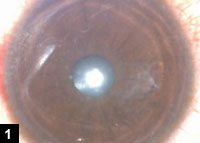 Epithelial ingrowth may be secondary to one of two mechanisms in a patient after LASIK. | 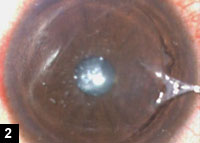 The flap is reflected and the ingrowth is removed by peeling off as a sheet using fine forceps. |
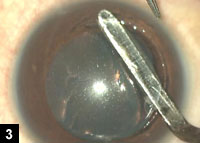 Patient with epithelial ingrowth after nasal hinge flap. Flap is being lifted with a spatula. | 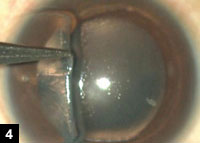 Epithelial ingrowth from the undersurface of the flap is removed. Images: Agarwal A |
Forms of epithelial ingrowth
Epithelial ingrowth can exist in two forms.
The benign form is seen within 2 mm of the flap edge and may be diffuse or localized. It may be slowly progressive or nonprogressive and may sometimes disappear after a few months, leaving a residual haze in the interface.
The aggressive form appears in the shape of cell nests – pearl-like small islands, sheaths, colonies, strands or cysts without any demarcating white line. As the condition progresses, these nests become whitish and tend to merge together.
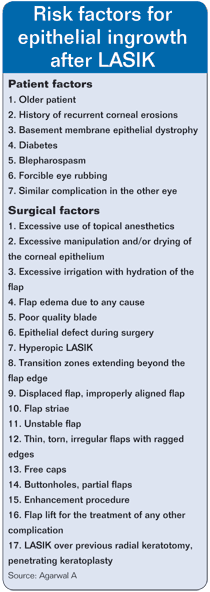
Complications
Epithelial ingrowth may induce regular and irregular astigmatism with resulting decreased vision. It may also result in melting of the flap or the stromal bed. Epithelial fistulas may be formed near the flap margin. Clinically significant ingrowth may interfere with diffusion of nutrients between aqueous and flap tissue. Collagenase and protease enzymes that are released by necrotic epithelial cells may result in stromal and flap melting. Presence of stromal inflammation may be an early sign of necrosis.
Treatment
The limited, benign form of epithelial ingrowth, 2 mm in diameter or less, does not require treatment. Treatment is required only when epithelial ingrowth interferes with or threatens to interfere with visual acuity by encroaching onto the visual axis or by causing other complications such as irregular astigmatism or threatening to cause stromal necrosis or flap melt. Treatment is also indicated in case of symptomatic ingrowth. Numerous techniques have been described for the management of epithelial ingrowth. Techniques for removal include scraping of epithelial ingrowth and excimer laser phototherapeutic keratectomy (PTK). The flap is reflected and the ingrowth is removed by peeling off as a sheet using fine forceps (Figure 2) or by scraping from both the stromal bed as well as the undersurface of the flap (Figures 3 and 4). The bed is then irrigated well before replacing the flap. Excimer laser PTK may also be used to remove the epithelial cells. Adjuncts such as cryotherapy, cocaine, Nd:YAG laser, mitomycin C and sutures may lead to a decreased incidence of recurrence. Some authors have reported success with ethanol and laser therapy for recurrences. The major problem in the management of epithelial ingrowth is the high incidence of recurrence after treatment. Recurrence of epithelial ingrowth after treatment has been reported to be as high as 44%.
Recurrence of ingrowth can be caused by improper adhesion of the flap to the bed, which leaves behind a potential space for the cells to grow into. It has been suggested to place interrupted sutures with just enough tension to appose the flap to the bed without inducing striae at the site of ingrowth after epithelial removal. Remove the sutures after 1 month.
For More Information:
- Amar Agarwal, MS, FRCS, FRCOphth is director of Dr. Agarwal’s Group of Eye Hospitals. Dr. Agarwal is author of several books published by SLACK, Incorporated, publisher of Ocular Surgery News, including Phaco Nightmares: Conquering Cataract Catastrophes, Bimanual Phaco: Mastering the Phakonit/MICS Technique, Dry Eye: A Practical Guide to Ocular Surface Disorders and Stem Cell Surgery, and Presbyopia: A Surgical Textbook. He can be reached at 19 Cathedral Road, Chennai 600 086, India; fax: 91-44-28115871; e-mail: dragarwal@vsnl.com; Web site: www.dragarwal.com.
References:
- Agarwal S, Agarwal A, Agarwal A. Four volume textbook of ophthalmology. India: Jaypee; 2000.
- Agarwal A. Handbook of Ophthalmology. Thorofare, NJ: SLACK Incorporated; 2005.
- Agarwal A. Refractive Surgery Nightmares. Thorofare, NJ: SLACK Incorporated; 2007.
